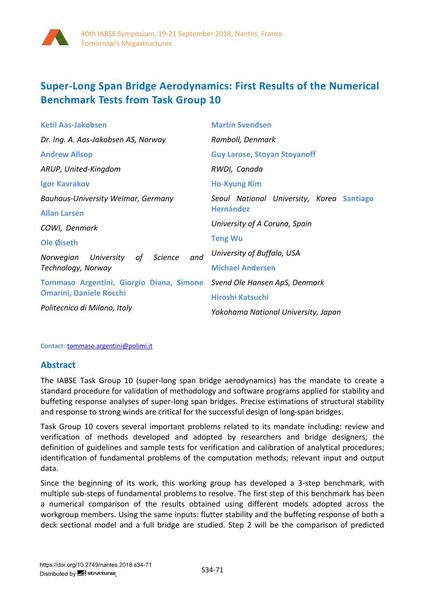Super-Long Span Bridge Aerodynamics: First Results of the Numerical Benchmark Tests from Task Group 10

|
|
|||||||||||
Détails bibliographiques
| Auteur(s): |
Ketil Aas-Jakobsen
(Dr. Ing. A. Aas-Jakobsen AS, Norway)
Andrew Allsop (ARUP, United-Kingdom) Igor Kavrakov (Bauhaus-University Weimar, Germany) Allan Larsen (COWI, Denmark) Ole Øiseth (Norwegian University of Science and Technology, Norway) Tommaso Argentini Giorgio Diana Simone Omarini (Politecnico di Milano, Italy) Daniele Rocchi (Politecnico di Milano, Italy) Martin Svendsen (Ramboll, Denmark) Guy Larose (RWDI, Canada) Stoyan Stoyanoff (RWDI, Canada) Ho-Kyung Kim (University of A Coruna, Spain) Teng Wu (University of Buffalo, USA) Michael Andersen (Svend Ole Hansen ApS, Denmark) Hiroshi Katsuchi (Yokohama National University, Japan) |
||||
|---|---|---|---|---|---|
| Médium: | papier de conférence | ||||
| Langue(s): | anglais | ||||
| Conférence: | IABSE Symposium: Tomorrow’s Megastructures, Nantes, France, 19-21 September 2018 | ||||
| Publié dans: | IABSE Symposium Nantes 2018 | ||||
|
|||||
| Page(s): | S34-71 | ||||
| Nombre total de pages (du PDF): | 10 | ||||
| DOI: | 10.2749/nantes.2018.s34-71 | ||||
| Abstrait: |
The IABSE Task Group 10 (super-long span bridge aerodynamics) has the mandate to create a standard procedure for validation of methodology and software programs applied for stability and buffeting response analyses of super-long span bridges. Precise estimations of structural stability and response to strong winds are critical for the successful design of long-span bridges. Task Group 10 covers several important problems related to its mandate including: review and verification of methods developed and adopted by researchers and bridge designers; the definition of guidelines and sample tests for verification and calibration of analytical procedures; identification of fundamental problems of the computation methods; relevant input and output data. Since the beginning of its work, this working group has developed a 3-step benchmark, with multiple sub-steps of fundamental problems to resolve. The first step of this benchmark has been a numerical comparison of the results obtained using different models adopted across the workgroup members. Using the same inputs: flutter stability and the buffeting response of both a deck sectional model and a full bridge are studied. Step 2 will be the comparison of predicted results and experimental tests in wind tunnels, and Step 3 will be of validation against full scale measurements. In this paper, the results of Step 1 will be presented, highlighting critical issues and differences found during the comparison of results. The response of a 3-degrees of freedom bridge deck will be presented both in terms of aeroelastic stability and buffeting response. The results presented are intended to be a reference for the validation of methodologies and software programs that solve for wind response of bridges. |
||||
